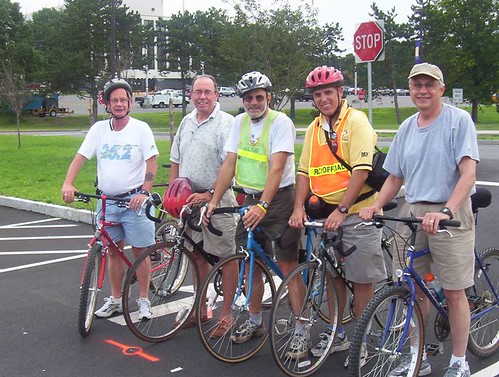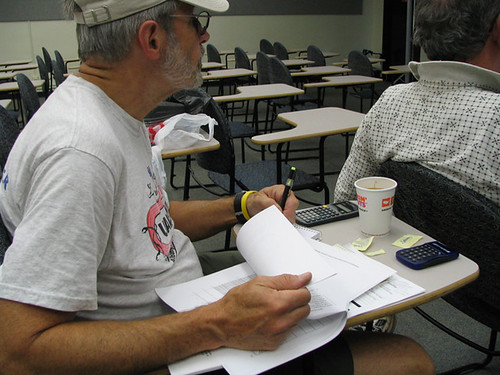Per agreement between RRTC Chairman Gene Newman and MN Editor Kevin J. Lucas, the following post is a correction to substantive editorial changes made without review by authors Jim Gilmer and Mike Wickiser to the article titled "USATF RRTC Course Measurement and Certification Workshop, July 29, 2006 — Albany, New York" that was published in Measurement News, Fall 2006, issue #133, p. 42.
Excerpts from Jim Gilmer's Sept. 18 letter to MN Editor Kevin J. Lucas outline the most substantive disparities from the original submission as follows:
"By my count at least 11 editorial changes were made to a simple 400 word report. Words were changed for no apparent reason other than stylistic preference. Entire phrases that we did not write were inserted. And a sentence that we did write summarizing one participant’s experience of the workshop was deleted! These editorial modifications were all made without our explicit permission and without the courtesy of a request or explanation from you, as I had asked.
"More importantly, the cumulative effect of these editorial changes clearly imparted a negative connotation to what was a relatively unbiased article. Specifically, we did not write that the “initial 2 day” [¶1] workshop was “shortened” [¶3], and we certainly did not portray the participants as “not yet ready to tackle a measurement on their own” [¶6]. Those simply were not our words. It is difficult for me to understand how someone not present at the workshop could render such a negative assessment when the article we submitted described an enthusiastic group who stayed for a very long day and left in high spirits willing to help out in the future.
"In another editorial change, the last sentence of the submitted text was completely deleted from the published article. In our submission this sentence read:
“One participant – a 50 States marathoner – commented in an e-mail that he had no idea so much knowledge, work, and detail went into measuring a course for certification.”"
--------------------------------------------------------------------------------
The following is the article as originally submitted.
USATF RRTC Course Measurement and Certification Workshop
July 29, 2006 — Albany, New York
By Mike Wickiser and Jim Gilmer

Workshop participants at the end of their recently measured 1000 foot calibration course.
From left to right: Jim Thomas, Gary Gelvin, Ray Lee, Jim Gilmer, and Jeff Gleba.
To promote USATF course certification and bolster the number of capable course measurers in New York, George Regan, Executive Vice-President of the Adirondack Association, and Jim Gilmer, New York State Certifier, asked Mike Wickiser, RRTC Workshop Coordinator, to conduct a course measurement workshop in Albany, NY. Notice of this workshop was placed on the USATF Associations listserv as well as the RRTC Course Measurement bulletin board.
Working on the local front, Jim Gilmer secured a venue for the mid-summer’s workshop at the University of Albany, with the assistance of long-time runner Prof. Ed Thomas. With an air-conditioned classroom, convenient location to a calibration course, and a twisting turning closed loop course to practice measuring, the university proved to be a most satisfactory setting for the day’s activities.
The workshop, held on Saturday, July 29 from 8:00 am to 5:00 pm, started out with the group setting goals for the day. Participants decided they wanted a combination lecture and ‘hands on’ approach to encompass measuring and USATF certification. This was followed by a viewing of Tom McBrayer’s short measurement video. The discussion portion of the workshop covered the construction and use of calibration courses and the calibrated bike measurement method, following the Measurement Manual as a guide.

Ray Lee takes notes during discussion at the workshop
Working between the classroom and the field on the UA campus, the group accomplished the following:
· Laid out and team-measured a calibration course
· Worked through and temperature-adjusted of a calibration course
· Measured the campus perimeter road for certification
· Practiced offsetting around traffic, barriers, and moving points using the “3-4-5” right triangle technique
· Determined the Working Constants & Final Constants for the day
· Crunched the data to determine final course measured length
Though none of the participants had any prior experience in course measurement, interest level was high. The group decided to forego lunch and breaks and continue straight through with discussion and field practice. As a result of the activities completed at the workshop, both the 1000’ calibration course and the 2.8 mile closed loop course were certified.
Evaluations completed after the workshop reflected a high level of satisfaction with the instructor, as well as the course materials, activities and venue. Importantly, all participants indicated a willingness to assist with course measurement in the future. One participant – a 50 States marathoner – commented in an e-mail that he had no idea so much knowledge, work, and detail went into measuring a course for certification.
